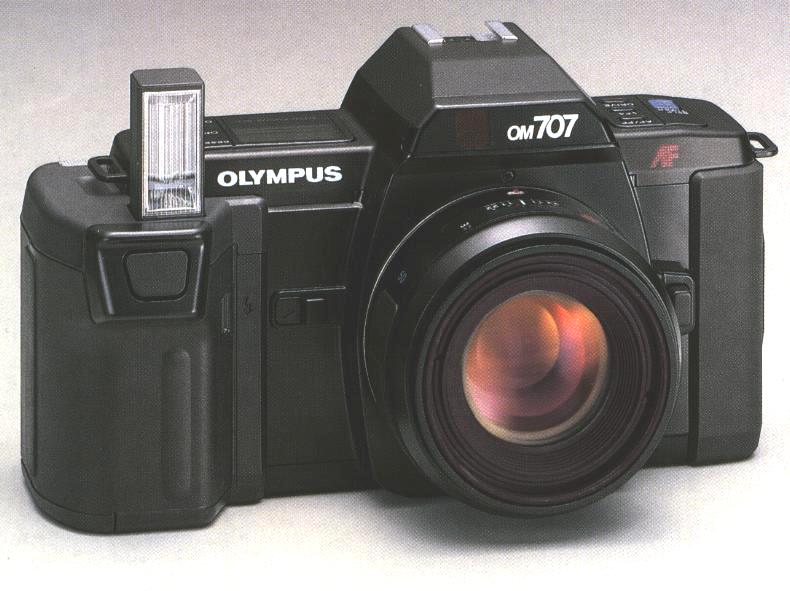
Body group OM-707

Body group OM-707
In 1986, one year after the introduction of the first true Autofocus SLR camera, the
Minolta 7000, Olympus introduced its own AF amateur model: the OM-707, together with eight
AF Olympus lenses. It would remain the only OM camera with AF. Where Canon and later Nikon
succesfully introduced AF in their professional models, Olympus hesitated and considered
AF just a gadget that was supposed to be only interesting for amateurs. By the time
Olympus admitted its mistake it was too late and the market for professional AF cameras
was taken by Canon (with Nikon trying to catch up). But it remains a pity that Olympus
didn't even try to market a camera that had at least some more serious specs than the
OM-707. With the addition of just a few options, used in earlier OM models, this could
have been a nice camera. Manual mode, aperture and shutter speed preferred AE with AF
lenses, spot metering, exposure compensation, viewfinder information with non-AF Zuiko
lenses and DX film speed code overrule are all missing, and this makes the OM-707 a camera
targeted at the amateur for carefree shooting, much like the Olympus iS-100 and Olympus
Centurion cameras. With AF lenses there's only Program Mode with program shift option, and
an AE lock button to influence exposure. MF Zuiko lenses are supported with aperture
preferred AE, but without viewfinder information, which makes it rather useless for
serious photography.
The facts that it was 'the first AF SLR in the word to feature built-in flash' (well
actually there was an exchangeable Power Flash Grip), has a built in AF support light and
supports the F280 flash that synchronizes at all shutter speeds up to 1/2000, with an
extra AF assist light on this flash and that the camera has a higher sync speed of 1/100
sec. and a built-in Winder (1.5 fps) don't help enough to make it a much better camera.
AF is rather slow, with just one AF spot, and the camera looks like a brick compared with
all other OM models.
From now on, Olympus explored all modernisations including AF only in its iS- and Camedia
camera series, with the iS-3000 and Camedia E-10 reaching a very high technical level; the professional OM
line reached its end with the OM-4Ti and OM-3Ti.
The OM-707 was only available in black.

Main specifications
| Type: Autofocus, auto-exposure 35 mm SLR camera. | Viewfinder: Focusing screen: Fixed, Super Lumi-Micron Matte with autofocus frame. Finder view-field: 93% of actual picture field. Magnification: 0.8x at infinity with 50mm standard lens. |
| Film format: 24x36mm. | Viewfinder information: Type: LCD display, back illumination by LED. Focus display; shutter speed2; aperture2; over-/under-exposure warning2; flash display; power focus diplay. Display limiter: approx. 30 sec. |
| Lens mount: Olympus OM mount, designed for AF lenses. Accepts Olympus AF lenses and Olympus OM System Zuiko lenses1. | LCD panel information: Film speed; battery level; Program mode; AF/PF mode; Single / Continous Winding Mode; film counter; film not loaded indicator; self-timer indicator; Flash F4 Mode. |
| Shutter: Electronically controlled vertical-travel focal-plane shutter. Shutter speed: 2-1/2000 sec. | Film loading: Auto-loading (automatically wound to first frame). |
| Synchronization: Hot shoe: Super FP flash contact; X contact; T-series flash contact. | Film wind: Automatic wind; Single / Continous switchable. Max. wind speed: approx. 1.5 frames per sec. Automatically stopped at film end. |
| Autofocus: Method: TTL phase detection system with CCD Zero-in Sensor. Focusing sensitivity range: EV4~EV18 (ISO 100). Actuation method: Single or Continuous. Focus lock possible. Indication: Single point 2 color LED in viewfinder; focussed: green lamp; autofocus impossible: red lamp. | Battery life: With Power Flash Grip 300: 8 rolls or more (half with flash). With Power Flash Grip 100: 25 rolls or more [RO3 (AAA) battery (alkaline-manganese), normal temperature 24-exposurecassette]. |
| AF illuminator: Automatic actuation in low light. | Exposure counter: Progressive type, displayed on LCD panel. |
| Manual focus: Olympus AF lenses: By shift/power focus knob; OM Zuiko lenses: focus ring. | Film rewind: Automatic rewind with rewind button. Automatic stop at film end. |
| Light metering method: Exposure control: TTL Direct "OTF" Light metering (center-weighted, average light measurement). | Self-timer: 12 sec. delay electronic self-timer. |
| Exposure modes: Multi-program: (1) Program. (2) Program shift by shift/power focus knob. (3) Automatic program shift based on focal length of lens. (4) Aperture preferred AE when using Olympus OM Zuiko lenses. | Power source: Supplied by Power Flash Grip 300 or Power Grip 100; Four RO3 (AAA) alkaline-manganese batteries. |
| Program auto-exposure: Type: Electronic shutter with automatic control of shutter speed and aperture. Light measuring range: EV1~EV20 (ISO 100, 50mm F1.8). | Battery check: 3-step display in LCD panel. |
| AE lock: AE lock possible by AE lock button. | Data hold: Static memory for necessary functions. |
| Flash control: Full-Synchro flash F280: Automatic selection of Normal "OTF" Flash or Super FP Flash. Power Flash Grip 300: Flashmatic. T-Series Flash: TTL Direct "OTF" flash. Regular flash units: Normal Auto flash with "Flash F4 Mode". | Dimensions: 146 x 89 x 52 mm. (when Power Grip 100 connected, without protruding section). |
| Automatic film speed setting: Automatic setting for film with DX code. Range: ISO 25-3200. | Weight: 595g (with Power Grip 100, without batteries). 635g (with Power Flash Grip 300, without batteries). |
1 The Zuiko 500/8, Zuiko 600/6.5, Zuiko 1000/11 and Auto Bellows can't be
used.
2 Only with Olympus AF lenses.